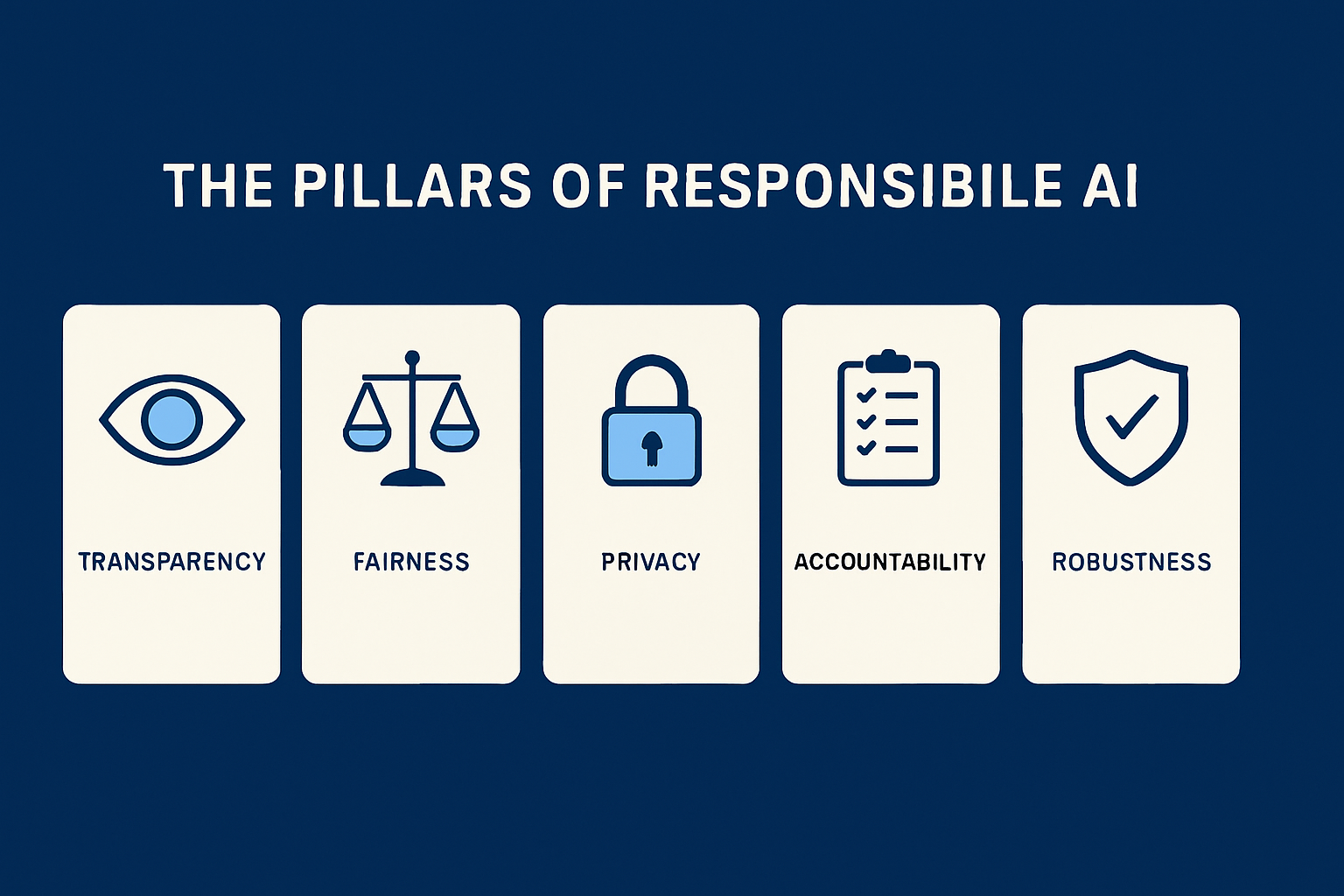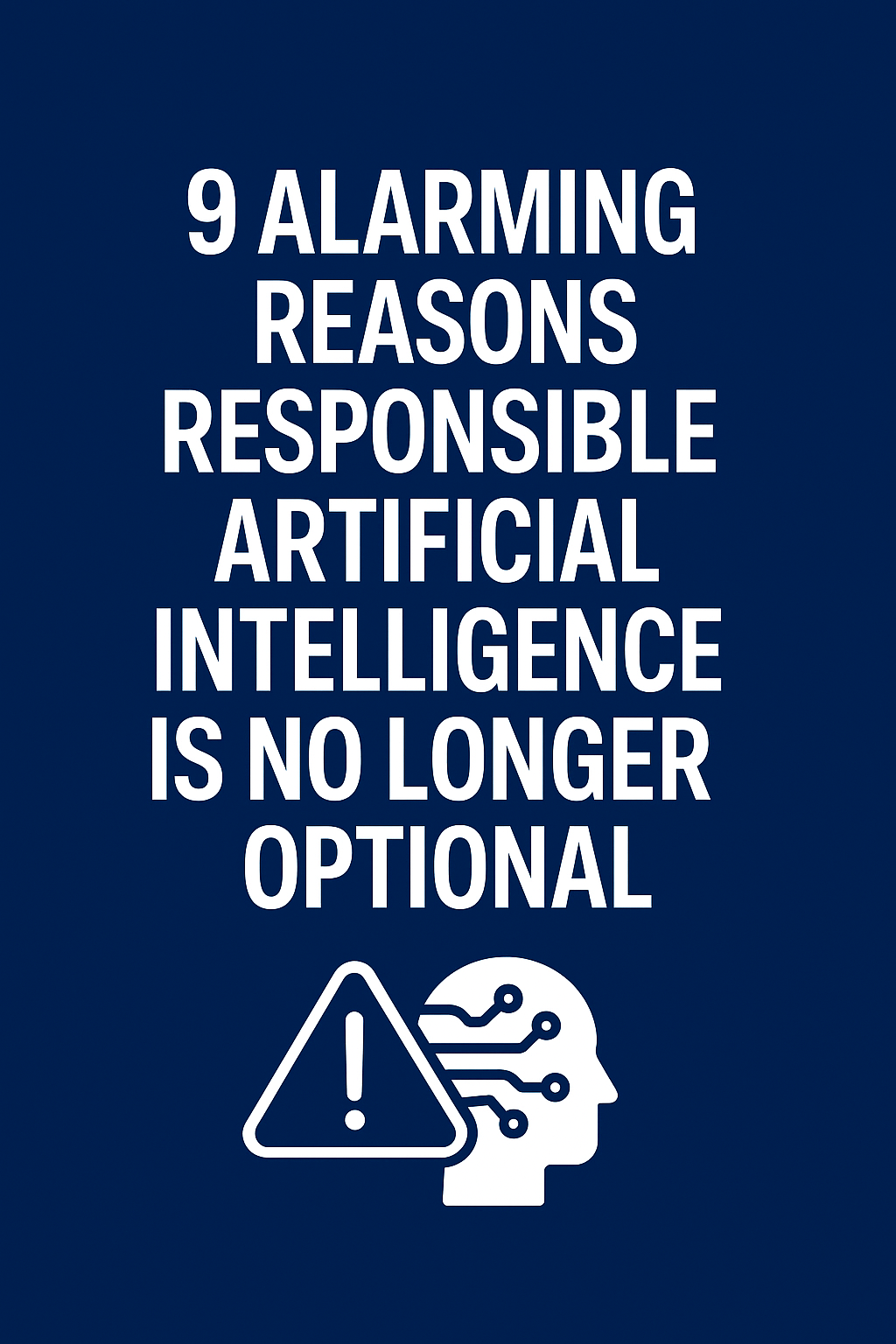Artificial intelligence is no longer a futuristic concept. It’s now embedded in everything from medical diagnostics to mortgage approvals, from hiring processes to national security systems. But as AI systems grow more powerful, the urgent need for responsible artificial intelligence becomes harder to ignore.
In 2024, over 60% of global CEOs reported being “concerned” or “extremely concerned” about the ethical implications of AI in their operations (PwC Global CEO Survey). And with regulators catching up fast — such as the EU AI Act or the U.S. AI Bill of Rights — organizations that fail to adopt responsible AI may not just face fines but lose user trust altogether.
Let’s break down the real-world reasons responsible AI is no longer optional, how you can approach it practically, and where to start.
Why Responsible Artificial Intelligence Matters

Responsible artificial intelligence is a framework for developing and deploying AI systems that are transparent, fair, safe, and accountable. It ensures AI behaves in a way that aligns with ethical principles, societal norms, and human rights.
This isn’t just a philosophical discussion — the stakes are real. From biased recruitment tools to facial recognition errors that have led to wrongful arrests, AI can (and has) caused harm. Responsible AI is about putting guardrails in place before the next disaster strikes.
1. Biased AI Models Are Already Hurting Real People
AI doesn’t make decisions in a vacuum — it learns from data. But if the data contains biases, so will the output. In 2018, Amazon scrapped its AI hiring tool because it penalized female applicants. The model had learned from resumes submitted over a decade — mostly by men — and inferred male dominance as a signal for competence.
In healthcare, a widely used risk prediction algorithm showed racial bias, giving Black patients lower risk scores than white patients with the same health conditions (Obermeyer et al., 2019). Without responsible AI practices in place, these biases persist silently — at scale.
2. Black Box Algorithms Erode Public Trust
Would you accept a medical diagnosis from a doctor who couldn’t explain it? Most people wouldn’t. Yet this is what many “black box” AI systems do: produce outcomes with no transparency on how decisions are made.
Responsible artificial intelligence insists on explainability — the ability for AI systems to communicate how they reached a particular output. It’s not just about user trust; it’s increasingly becoming a compliance requirement. The EU AI Act, for example, mandates explainability for high-risk applications.
3. AI Can Amplify Inequality Without Guardrails
Left unchecked, AI systems can exacerbate systemic inequalities. Predictive policing algorithms have been found to target communities of color more heavily. Loan approval algorithms have denied credit to women and minorities at higher rates.
Responsible AI frameworks emphasize fairness audits, impact assessments, and bias mitigation. These are not technical luxuries — they are social responsibilities.
4. Ethics-Washing Is the New Greenwashing
It’s easy for companies to publish “AI Principles” on a web page. But ethical AI is not a marketing exercise. Without implementation, monitoring, and accountability, these declarations are just window dressing.
Real responsible artificial intelligence involves:
- Establishing an AI Ethics Committee
- Conducting regular model audits
- Documenting data provenance and labeling
- Using open-source fairness tools like Fairlearn or Aequitas
5. Legal Frameworks Are Catching Up Fast
Regulations that were once vague are becoming enforceable laws. The EU AI Act classifies AI applications by risk level, requiring strict obligations for “high-risk” systems. Penalties can go up to €30 million or 6% of annual global revenue.
In the U.S., the Blueprint for an AI Bill of Rights outlines clear expectations around data privacy, algorithmic discrimination, and transparency. Countries like the UAE and Singapore are also creating responsible AI sandboxes to test and enforce ethical use.
Failing to prepare now could mean expensive remediation later — or getting banned from markets entirely.
6. AI Mistakes Can’t Always Be Undone
In traditional software, bugs can be patched. But in AI, especially with systems that self-learn in production, the consequences of mistakes can’t always be rolled back. Facial recognition errors, medical misdiagnoses, and discriminatory recommendations can have lasting impacts on individuals.
Responsible AI encourages a “design for failure” mindset — building with monitoring, human oversight, and fallback plans in place.
7. Without Human Oversight, AI Is a Liability
One of the core principles of responsible artificial intelligence is human-in-the-loop (HITL) systems. HITL means AI augments human decision-making rather than replacing it completely. For example, in a criminal justice application, AI might recommend parole decisions — but a judge should have the final say.
This balance of automation and human judgment helps prevent overreliance on flawed or evolving models, especially in high-stakes domains.
8. Ethical AI Is Becoming a Competitive Advantage
According to an Accenture report, companies that embed ethical principles into AI development see a 25% higher trust score from users. Ethical AI is no longer just a compliance checkbox — it’s a brand differentiator.
OpenAI’s partnership with Microsoft and Anthropic’s “constitutional AI” approach are examples of companies building their entire strategies around transparency, fairness, and safety.
Responsible AI is how you future-proof your technology stack and reputation.
9. Stakeholders Are Demanding Responsibility
Investors are increasingly looking at ESG (Environmental, Social, and Governance) metrics — and responsible AI falls right into the “S” and “G”. Employees want to work at organizations with ethical AI practices. Customers want assurances that their data isn’t being misused or fed into opaque algorithms.
Failing to meet these expectations means you’re not just behind — you’re at risk of becoming irrelevant.
How to Implement Responsible Artificial Intelligence in Practice

If you’re wondering where to begin, here’s a practical roadmap to implement Responsible Artificial Intelligence:
- Create an internal AI Ethics Task Force
- Map all current AI use cases in your org
- Evaluate risk levels using models like the AI Risk Matrix
- Run audits on datasets, models, and outcomes
- Use tools like SHAP, LIME, or Google’s What-If Tool for model explainability
- Establish feedback loops from users and stakeholders
- Track metrics on fairness, accuracy, and user impact over time
No system will be perfect. But the absence of a strategy is no longer an excuse.
Industry Examples Leading the Way
- Microsoft launched its Responsible AI Standard, requiring all teams to follow governance processes across the AI lifecycle.
- Salesforce created the Office of Ethical and Humane Use of Technology, offering internal guidance to every AI team.
- Singapore’s Personal Data Protection Commission released its Model AI Governance Framework, influencing policies across Asia.
These are not PR moves. They are operational frameworks being executed — and they’re setting the global standard.
Further Reading You’ll Find Useful
Want to go deeper? Check out our article on AI Ethics Research for real-world examples, data, and implementation strategies.
Also explore trusted sources like:
What Happens If You Ignore Responsible AI?
- Legal liabilities
- PR disasters
- Loss of customer trust
- Inability to scale into new regions
The cost of inaction is high. The longer you delay embedding responsible artificial intelligence into your systems, the more reactive — and vulnerable — your organization becomes.
Final Thoughts: This Isn’t Optional Anymore
AI is evolving faster than any previous technology. But progress without ethics isn’t innovation — it’s chaos. Responsible artificial intelligence isn’t about limiting potential. It’s about unlocking it responsibly.
Companies that lead in this space will not only win markets — they’ll win trust. And in the age of AI, trust is the only true currency.
Disclaimer
This article is for informational purposes only. While we strive for accuracy and relevance, the content should not be considered legal or professional advice. Readers are encouraged to consult with qualified experts or regulatory bodies before making decisions based on AI implementation strategies discussed here. Use this information at your own discretion and risk.
If you found this helpful, share it with a colleague or leave your thoughts below. Want to learn more about ethical AI frameworks? Check out our full AI ethics series on Digital Ailiens.
Why is responsible AI important?
Responsible AI is critical because it prevents harm caused by biased models, ensures transparency, builds trust, and complies with emerging regulations like the EU AI Act.
What is responsible artificial intelligence?
Responsible artificial intelligence refers to the development and deployment of AI systems that are ethical, transparent, fair, accountable, and aligned with human values and societal norms.
How does bias affect AI systems?
Bias in AI systems occurs when the training data reflects historical prejudices or lacks diversity, leading to unfair or discriminatory outcomes against certain groups.
What are the pillars of responsible AI?
The five pillars are transparency, fairness, privacy, accountability, and robustness—each ensuring AI is ethical and trustworthy.
How can companies implement responsible AI?
By establishing ethical guidelines, conducting bias audits, setting up governance frameworks, using explainability tools, and involving human oversight in AI decision-making.
What is AI explainability?
Explainability means AI systems should provide clear, understandable reasons behind their decisions to users and stakeholders.
What are the risks of ignoring responsible AI?
Ignoring responsible AI can lead to legal penalties, loss of customer trust, PR crises, and barriers to scaling technology globally.
What is AI ethics washing?
AI ethics washing refers to superficial ethical statements by companies without real implementation, monitoring, or accountability.
Are there regulations around responsible AI?
Yes, regulations like the EU AI Act, U.S. AI Bill of Rights, and frameworks in UAE and Singapore guide ethical AI deployment.
What tools help with bias detection in AI?
Tools such as Fairlearn, Aequitas, SHAP, and LIME assist in detecting and mitigating bias in AI models.
What is human-in-the-loop (HITL) in AI?
HITL means AI supports human decisions but does not replace human judgment, ensuring oversight and accountability.
How does responsible AI benefit businesses?
It builds trust, reduces legal risks, enhances brand value, and creates competitive advantage.
What industries need responsible AI the most?
Healthcare, finance, law enforcement, hiring, and marketing are critical sectors where ethical AI is essential.
Can responsible AI prevent AI mistakes?
While it can’t eliminate all errors, responsible AI reduces risks through monitoring, audits, and fallback mechanisms.
Where can I learn more about AI ethics?
Trusted sources include OECD principles, IBM’s Trustworthy AI, Microsoft’s Responsible AI standards, and your own AI ethics research blog.

